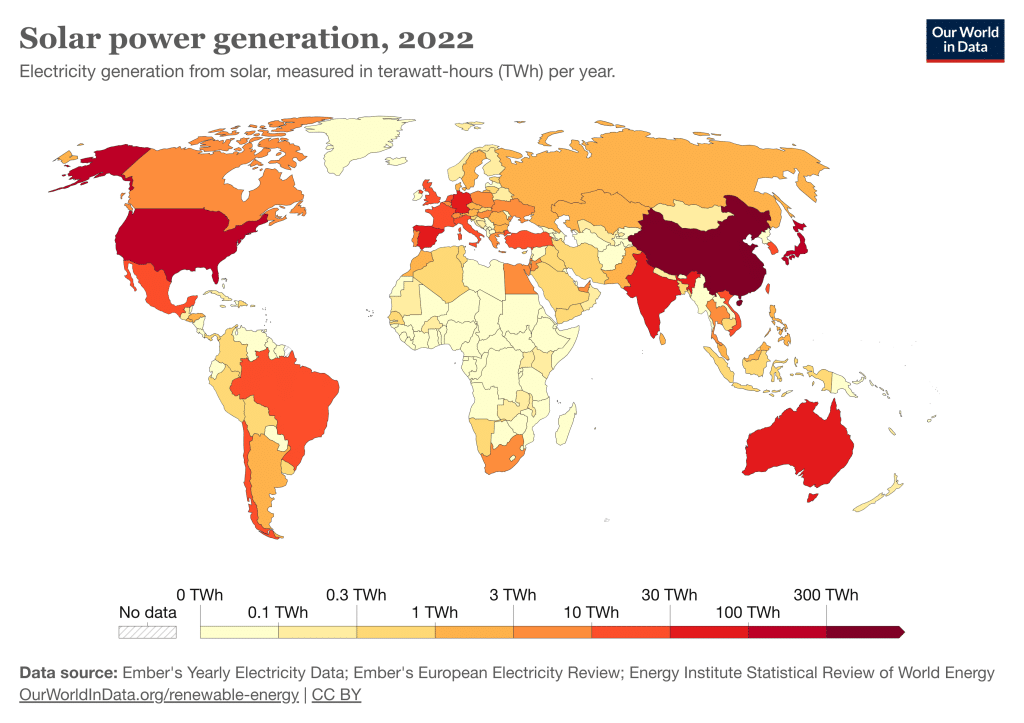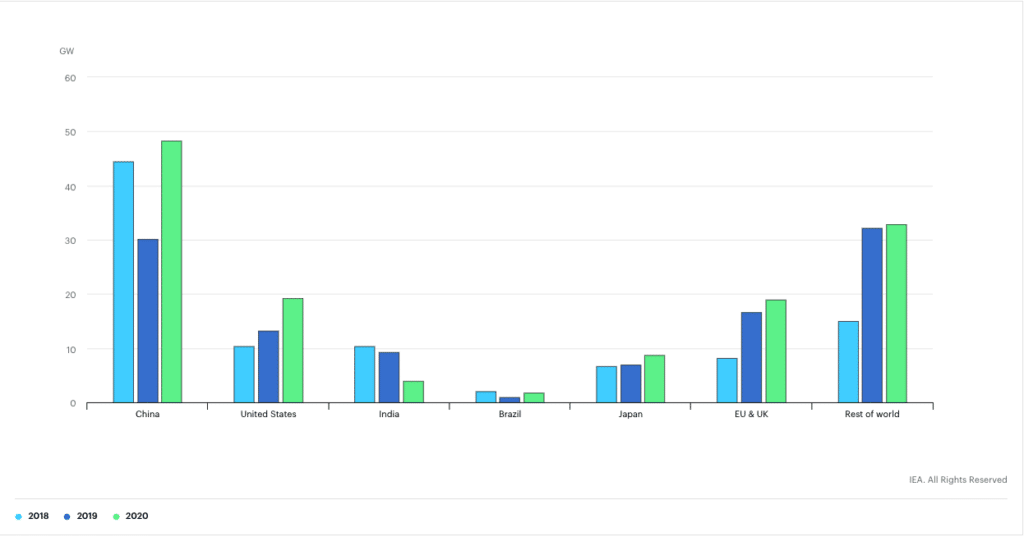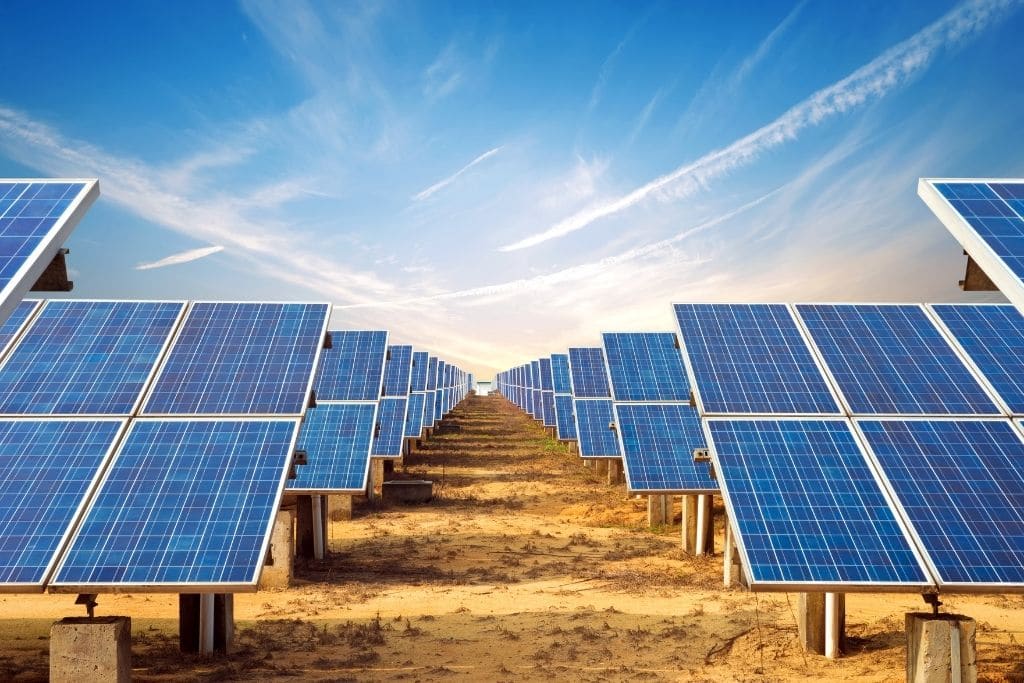Solar energy is a renewable energy source in which it can generate clean and sustainable electricity without producing planet-warming greenhouse gas emission or toxic pollution in the process. As time is ticking before the world crosses the tipping point to limit global temperature increase under 1.5C, switching to renewable energy such as solar is now more crucial than ever. Here are 12 solar energy facts to help make the argument.
—
While solar energy can be dated all the way back in 700BC, it was not widely commercialised until about 40 years ago and accepted as a clean and effective alternative to fossil fuels. Though developing countries enjoy the advantage of being located in regions where they have optimal access to the sun’s rays, the lack of investment and climate debt means solar energy has been slow to grow in the region. Meanwhile, developed countries such as America, Australia, and more recently, China, have become the leaders in solar power generation.
Interesting Solar Energy Facts
1. Solar is the Most Abundant Energy Source on Earth
Solar energy refers to light and heat radiation from the sun that is harnessed to generate electricity. While we scale up technologies across the globe to capture and convert solar energy, the Earth already receives it in spades. An hour and half’s worth of solar energy that reaches to the surface of the planet has enough power to meet all of humanity’s energy consumption for an entire year. Since the sun is not going away anytime soon, we have the ability and technology to depend on solar energy entirely and end the global use and consumption of fossil fuels.

2. Solar is the Fastest and Most Popular Form of New Electricity Generation
In 2010, solar energy represented only 0.06% of the global energy mix. Within nine years, solar rose up to 1.11%. Solar also makes up the largest proportion of growth in the renewable energy mix, where it grew from 0.8% in 2010 to 10.3% in 2019. Solar power capacity is rapidly growing at the same time, meaning the amount of electricity it can generate from energy it captures. Global solar power rose by 22% in 2020 as installations have experienced a boom. Together with wind power, renewable output has more than doubled since 2015.
3. Minimal Greenhouse Gas Emissions are Generated in a Solar Life Cycle
While the process of solar power generation does not emit any greenhouse gases, other stages of the life cycle do produce some, but minimal, emissions. This include the manufacture of solar cell and panel materials – primarily made of monocrystalline, polycrystalline, or thin film (“amorphous”) silicon – transportation, installation, maintenance, and decommissioning and dismantlement. Most estimates of life-cycle emissions for photovoltaic (PV) solar cell systems are between 0.07 and 0.18 pounds of carbon dioxide equivalent per kilowatt-hour.

4. Solar PV Accounts for 3% of Global Electricity Generation
Power generation from solar PV in 2020 grew by a record 156 TWh to reach 921 TWh, marking 23% growth from 2019, and accounts for 3.1% of global electricity generation. China, one of the world’s top greenhouse gas emitters, alone was responsible for 75% of the increase in annual solar PV installations from 2019 to 2020.
5. Solar Power Plants Can Last 40 Years or More
Aside from solar PV cell systems, energy can be generated with solar power plants where panels within an infrastructure can last at least 40 years. Panels can be easily replaced and updated with new and more efficient modules at relatively low costs, ensuring a long lifespan of these power plants.
If you like these solar energy facts, you might also like: What the Future of Renewable Energy Looks Like
6. Solar Power Plants Does Have Some Environmental Impacts
According to the National Renewable Energy Laboratory (NREL), for a solar power plant to provide electricity for 1,000 homes, the facility would require 32 acres of land. In other words, to meet the energy consumption needs of the US, the plant would require 18,734,500 acres to be used for solar plants, which is equivalent to 0.8% of the entire country. Aside from land use, solar thermal power plants require water use and hazardous materials can be dangerous if not disposed of correctly.
7. Solar Will Become 35% Cheaper By 2024
One of the most notable solar energy facts is that solar costs will drop significantly within the next few years. Industry experts have predicted that the US will double its solar installations to four million by 2023 while global uptake is projected to soar as more countries turn to solar to help meet their climate goals. In 2021, Australia installed a record more than 3,000MW of rooftop solar panels, where almost one-third of Australian households have solar panels – the highest rate in the world. A positive uptake trend will allow solar costs to drop thanks to its accessibility. Some expect it decline by 15% to 35% by 2024, spurring further growth over the second half of the decade.
8. Solar Power in 2020 was the Cheapest Electricity in History
According to a 2020 report by the International Renewable Energy Agency (IRENA), solar power is now the cheapest electricity in history. In most major countries, solar technology is also cheaper than coal and gas.
You might also like: Can We Build Solar Power Systems in Space?
9. The Biggest Solar Farm in the World is in Morocco
The Noor Complex solar power farm is the world’s largest concentrated solar power (CSP) plant located in the Sahara Desert in Morocco. Its geographical location allows for optimal access to sunlight and is said to have a 580-megawatt capacity and can provide electricity to more than one million people.
10. China’s Solar Power Capacity is the Fastest Growing in the World
China installed the most new renewable energy capacity in 2021 and is expected to reach 1,200GW of wind and solar capacity in 2026, four years earlier than its target. By 2024, China will also likely register the largest installed residential solar capacity in the world. This growing trend contributes to China’s pledge to carbon peak by 2030 and to reach carbon neutrality by 2060. Unfortunately, the nation has also been increasing its coal use at the same time due to a recent energy crisis.
11. India Aims to be a Global Leader in Solar Energy
As part of the country’s 2070 net zero emissions strategy, the Prime Minister of India Narendra Modi pledged to increase its energy from renewable sources up to 50% by the end of 2030. One aim is to install 100GW of grid-connected solar power plants by 2022. Another overarching goal is to decentralise solar power and to widely distribute to meet the country’s cooking, lighting and other energy needs. However, pandemic lockdowns and supply chain issues have disrupted many project constructions, resulting in only less than 4GW of solar PV capacity being installed in 2020, almost 60% less than in 2019.
12. Recent Supply Chain Issues Could Hinder Solar Energy Growth
The COVID-19 pandemic has severely impacted the global economy in many ways, and the solar energy industry is expected to experience decline in growth due to rising costs in raw materials such as steel and aluminium, global supply chain bottlenecks, and elevated shipping costs from travel restrictions worldwide. Should this trend persists, this could deal a blow for countries to scale up solar energy production and capacity, forcing many to remain relying on fossil fuels such as coal and natural gas.
13. Solar Technologies Are Getting More Efficient
According to Rhone Resch, President of the Solar Energy Industries Association (SEIA), the global PV sector has been growing at an average of over 40% in the last eight years and major advances in automation, manufacturing, and throughput have considerably improved this technology. Most panels today are between 15% and 20% efficient, meaning that they are able to convert 15% to 20% of the amount of sunlight they absorb into electricity. Panels’ efficiency has improved consistently over the past decade, a promising factor and one that contributes to continued cost reduction. Furthermore, their resistance to extreme weather has been drastically improved, bringing their average durability to about three decades with little to no loss in efficiency.
You might also like: What Are the Advantages and Disadvantages of Solar Energy?
14. Scientists Are Exploring the Idea of Building Solar Power Stations in Space
Last on our list of solar energy facts is the futuristic, yet very likely possibility to build solar power stations in space. In 2020 European Space Agency (ESA) launched a campaign to collect new innovative ideas for technologies to increase the feasibility of space-based solar power to support the provision of clean energy and is now looking to fund some of these projects. Meanwhile, some prototypes are already underway in some countries.
As opposed to solar panels on Earth, which capture sunlight that has been absorbed and filtered through the atmosphere before reaching the ground, panels in space would be continuously and directly exposed to more powerful sunlight. This would allow a SSP-station to continuously generate an enormous amount of electricity. Indeed, it is estimated that space-based solar panels can generate up to 2,000 gigawatts of power constantly, nearly 40 times more energy than a solar panel would generate on Earth annually. SSP is not only considered more efficient than ground-based solar stations but it is also immaculately clean, infinitely available, and it has no impact on landscapes as it does not require any land use.
This story is funded by readers like you
Our non-profit newsroom provides climate coverage free of charge and advertising. Your one-off or monthly donations play a crucial role in supporting our operations, expanding our reach, and maintaining our editorial independence.
About EO | Mission Statement | Impact & Reach | Write for us


















